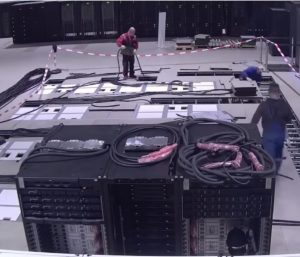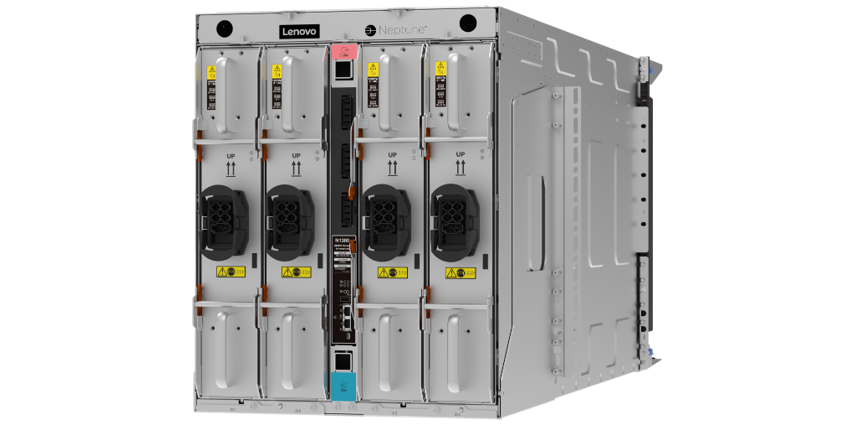 In this time-lapse video, engineers at the Jülich Supercomputing Centre begin building the new JUWELS supercomputer.
In this time-lapse video, engineers at the Jülich Supercomputing Centre begin building the new JUWELS supercomputer.
“When it comes to developing innovative supercomputer architectures, Europe is about to take the lead. A striking example of this is the new supercomputer that is due to start user operation at the Jülich Supercomputing Centre (JSC) in the next few days. JUWELS is a milestone on the road to a new generation of ultraflexible modular supercomputers targeting a broader range of tasks – from big data applications right up to compute-intensive simulations. With its first module alone, JUWELS qualified as the best German computer for the TOP500 List of the fastest supercomputers in the world published today. The system is being financed and utilized within the framework of the Gauss Centre for Supercomputing, which is funded by the federal government and the states in which the centre is located.”
Supercomputers are important in research when it comes to determining complex relationships, such as those in climate research or neuroscience. However, they are being applied more and more in other areas too. In addition to conventional applications like compute-intensive simulations in engineering, physics, or chemistry, supercomputers are increasingly used today for other tasks, such as the analysis of huge volumes of data or machine learning and artificial intelligence (AI). To meet such widely differing requirements, JUWELS (short for Jülich Wizard for European Leadership Science) has been designed as a modular supercomputer.
A computer like JUWELS is not an off-the-shelf solution,” says Professor Thomas Lippert, director of the Jülich Supercomputing Centre. “But as one of the largest German research centres, we are in a position to work together with our partners Atos from France and ParTec in Germany to develop the next generation of supercomputers ourselves. For us, modular supercomputing is the key to a forward-looking, affordable, and energy-efficient technology, which will facilitate the realization of forthcoming exascale systems.”
The flexible design conceived by Lippert – also referred to as smart exascale – developed into an extensive European undertaking years ago and was turned into a reality in the EU research project DEEP. Since 2011, experts from 16 European partners have been working together in the EU-funded DEEP projects coordinated by Dr. Estela Suarez from JSC. Last year, JURECA proved indispensable as the first modular supercomputer in productive operation at JSC. With JUWELS, a considerably more powerful modular system is now following in its footsteps.
More energy efficient than its predecessor
The modular concept comprises a supercomputer made of several specialized components that can be combined dynamically and flexibly depending on requirements using the ParaStation software of Munich HPC enterprise ParTec,” says Dr. Dorian Krause, department head responsible for the deployment and operation of JUWELS at JSC.
The Cluster module, which was supplied in spring 2018 by French IT company Atos in cooperation with software specialists at German enterprise ParTec, is equipped with Intel Xeon 24-core Skylake CPUs and excels with its versatility and ease of use. It has a theoretical peak performance of 12 petaflop/s, which is equivalent to the performance of 60,000 state-of-the-art PCs. The nodes are connected to a Mellanox InfiniBand high-speed network. “With our industry-leading 100 Gb/s and 200 Gb/s InfiniBand components, we are making an important contribution to the performance of this innovative system,” says Gilad Shainer, Vice President of Marketing at Mellanox.
Another unique feature of the module is its novel, ultra-energy-efficient warm-water cooling system. “This form of cooling of our patented and scalable BullSequana architecture makes it possible to cool the bulk of the waste heat with hot water without the need for additional cooling generators by utilizing the outdoor air,” explains Pierre Barnabé, Chief Operating Officer Big Data & Security Atos. This makes the first module of JUWELS more energy efficient than its predecessor JUQUEEN.
Model for exascale computers
Next year will see the arrival of a Booster module for massively parallel applications, amplifying the performance of JUWELS. The Booster will comprise a large number of ultra-energy-efficient processor cores connected to each other via a particularly powerful and fast network.
The Booster works a bit like a turbocharger. Complex parts of the code that cannot be processed efficiently on a large number of processors are executed on the Cluster. Program parts that can be efficiently processed in parallel can be exported dynamically with our ParaStation software to the Booster module,” explains Bernhard Frohwitter, CEO of ParTec and a patent lawyer. “This new technology, which was created in Europe and is being exploited here too, will enable every program part to be run in future on the most suitable module. Supercomputing innovations today come from Europe.”
Test run and practical use
In initial test runs with the LINPACK benchmark, the Cluster module achieved a peak performance of 6.2 petaflop/s despite the fact that it is designed with flexibility and universality in mind rather than speed. This makes the system the fastest German supercomputer, which 23th in the TOP500 List of the fastest supercomputers in the world released today at the International Supercomputer Conference (ISC).
The new supercomputer is already highly sought after by European researchers. Some 87 projects have already been allocated computing time. It is fully booked for the next few months. The system will be used for simulations, particularly those in brain research – an area where Jülich has assumed scientific leadership of the Human Brain Project – in developing new drugs, and in designing new materials. Scientists in the field of Earth systems research will use the system to develop next-generation high-resolution climate models. Many other applications come from the engineering sciences, the life sciences, and safety research as well as astronomy, physics, and chemistry.




